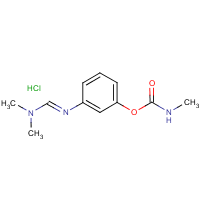Formetanate hydrochloride
Agent Name
Formetanate hydrochloride
CAS Number
23422-53-9
Formula
C11-H15-N3-O2.Cl-H
Major Category
Pesticides

Synonyms
3-Dimethylaminomethyleneiminophenyl-N-methylcarbamate, hydrochloride; Carzol; Carzol 92SP; Carzol SP; ENT-27566; EP-332; Formetanate HCl; Formetanate monohydrochloride; Morton EP 332; N,N-Dimethyl-N'-(((methylamino)carbonyl)oxy)phenylmethanimidamide monohydrochloride; Nor-AM EP 332; SN 36056; Schering 36056; m-(((Dimethylamino)methylene)amino)phenyl methylcarbamate hydrochloride; Methanimidamide, N,N-dimethyl-N'-(3-(((methylamino)carbonyl)oxy)phenyl)-, monohydrochloride; [ChemIDplus]
Category
Carbamate Insecticides
Description
Colorless or white solid; [HSDB]
Sources/Uses
Used as insecticide and acaricide for deciduous fruits, nuts, and alfalfa; [HSDB] Used on apples, pears, nectarines, peaches, oranges, grapefruits, lemons, limes, tangelos, tangerines, and alfalfa grown for seed; No longer used on late-season apples; [Reference #1]
Comments
Extremely toxic cholinesterase inhibitor; [CAMEO] May cause skin sensitization; [eChemPortal: ESIS] No farmworker poisoning cases reported since 1996; [Reference #1] See "CARBAMATE INSECTICIDES."
Reference Link #1
Biomedical References
Exposure Assessment
BEI
Acetylcholinesterase activity in red blood cells = 70% of individual's baseline; Butylcholinesterase activity in serum or plasma = 60% of individual's baseline; Sample at end of shift; [TLVs and BEIs]
Vapor Pressure
1.2E-08 mm Hg
Lethal Concentration
LC50 (rat) = 150 mg/m3
Adverse Effects
Skin Sensitizer
Yes
Other Poison
Carbamate
Diseases, Processes, and Activities Linked to This Agent
Diseases
Occupational diseases associated with exposure to this agent:
Processes
Industrial Processes with risk of exposure: